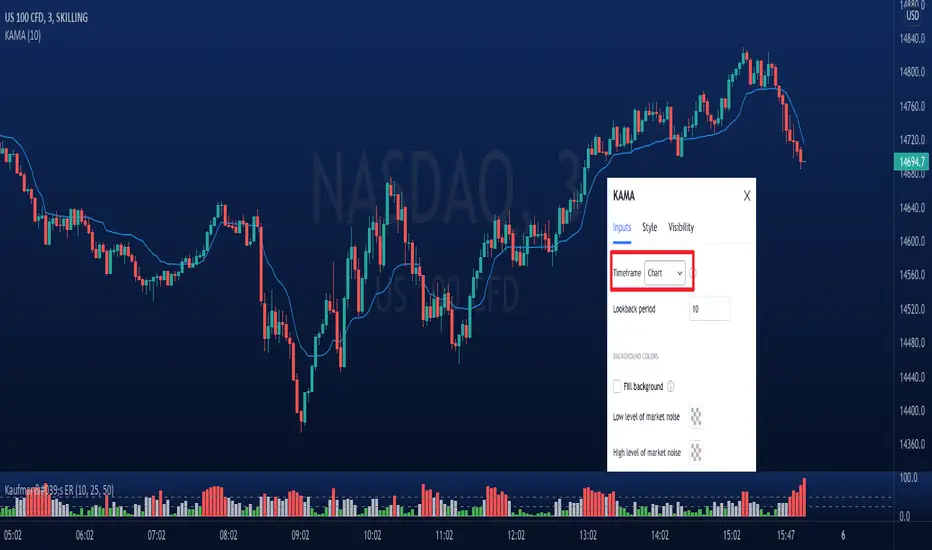OPEN-SOURCE SCRIPT
Aggiornato Kaufman's Adaptive Moving Average (KAMA) - Multi timeframe

Kaufman's Adaptive Moving Average (KAMA)
KAMA was developed by Perry Kaufman to give better directions of short term market trends.
Idea is similar to an EMA, but it makes adjustments to the smoothing factor by taking Market Noise into consideration. Levels of noise in KAMA is modelled using Kaufman's Efficiency Ratio.
The problem with traditional of moving averages (ie. SMA/EMA) is that they are very sensitive to sudden price movements.
Applications:
- Less prone to false signals compared to other types of moving averages. When price suddenly surges or tanks, KAMA will lag behind telling us that the move is rather abnormal.
- On the other hand, when volatility of price movements is low, KAMA will be close to the ranging candles with a slope approximate to zero. KAMA can be used for filtering out choppy markets.
Other features:
- Multi-timeframe.
- Can visualize levels of market noise with background color mode turned on.
KAMA was developed by Perry Kaufman to give better directions of short term market trends.
Idea is similar to an EMA, but it makes adjustments to the smoothing factor by taking Market Noise into consideration. Levels of noise in KAMA is modelled using Kaufman's Efficiency Ratio.
The problem with traditional of moving averages (ie. SMA/EMA) is that they are very sensitive to sudden price movements.
Applications:
- Less prone to false signals compared to other types of moving averages. When price suddenly surges or tanks, KAMA will lag behind telling us that the move is rather abnormal.
- On the other hand, when volatility of price movements is low, KAMA will be close to the ranging candles with a slope approximate to zero. KAMA can be used for filtering out choppy markets.
Other features:
- Multi-timeframe.
- Can visualize levels of market noise with background color mode turned on.
Note di rilascio
New feature: Coded candles to identify price crossing with MA.Note di rilascio
Amended line 43, calling of nz(src=kama, replacement=close). Previously, param. replacement==0Note di rilascio
Features:- Added: Option to show smooth KAMA (least of squares over same KAMA period).
- Added: Low/high thresholds for background colors linked to noise (if turned on)
- Removed: bar colors during crosses
Script open-source
Nello spirito di TradingView, l'autore di questo script lo ha reso open source, in modo che i trader possano esaminarne e verificarne la funzionalità. Complimenti all'autore! Sebbene sia possibile utilizzarlo gratuitamente, ricordiamo che la ripubblicazione del codice è soggetta al nostro Regolamento.
Read Faster & Learn Anything with Coral AI! getcoralai.com//?ref=dojiemoji
Declinazione di responsabilità
Le informazioni e le pubblicazioni non sono intese come, e non costituiscono, consulenza o raccomandazioni finanziarie, di investimento, di trading o di altro tipo fornite o approvate da TradingView. Per ulteriori informazioni, consultare i Termini di utilizzo.
Script open-source
Nello spirito di TradingView, l'autore di questo script lo ha reso open source, in modo che i trader possano esaminarne e verificarne la funzionalità. Complimenti all'autore! Sebbene sia possibile utilizzarlo gratuitamente, ricordiamo che la ripubblicazione del codice è soggetta al nostro Regolamento.
Read Faster & Learn Anything with Coral AI! getcoralai.com//?ref=dojiemoji
Declinazione di responsabilità
Le informazioni e le pubblicazioni non sono intese come, e non costituiscono, consulenza o raccomandazioni finanziarie, di investimento, di trading o di altro tipo fornite o approvate da TradingView. Per ulteriori informazioni, consultare i Termini di utilizzo.